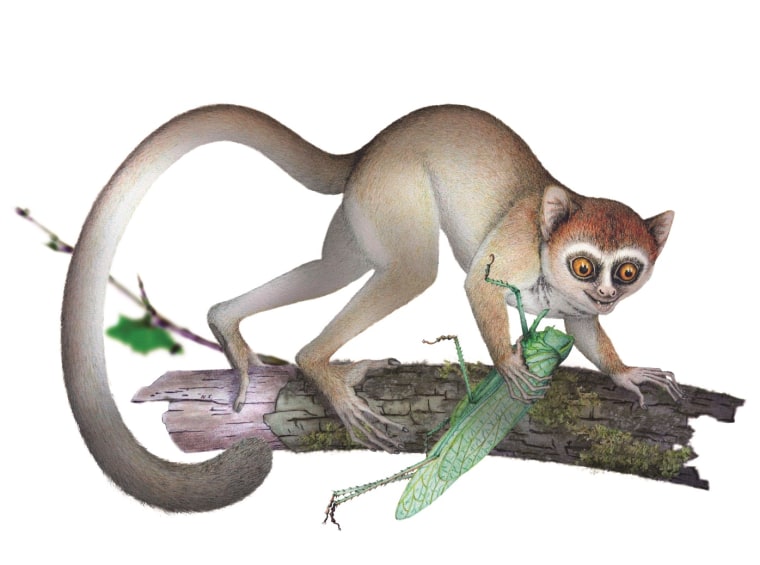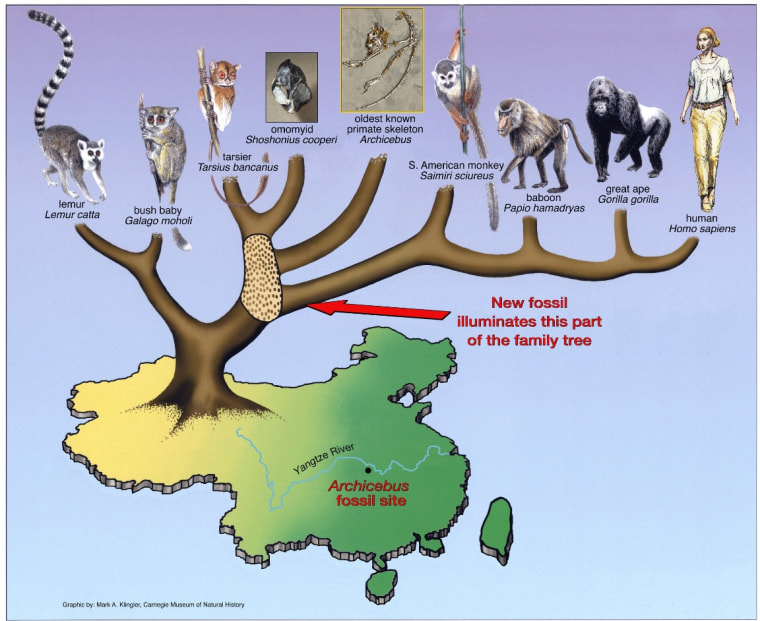
Researchers generally don't care for the term "missing link," but in the case of the oldest articulated primate skeleton ever discovered, paleontologist Christopher Beard says the missing-link label might almost be merited.
"It certainly in some ways could qualify for that term, in the sense that it's a hybrid, or a mosaic," he told NBC News. "It shows a combination of features that we've never seen before in any living or fossil primate. ... But I still would caution against it, because it's a loaded term."
More importantly, the mortal remains of a mouse-sized creature that lived 55 million years ago in China could provide new insights into our evolutionary roots — such as the incredibly small size and frenetic eating habits of our ancient forebears.
"This skeleton will tell us a lot of stories about the origin of primates, and about our remote ancestors," said Xijun Ni of the Chinese Academy of Sciences' Institute of Vertebrate Paleontology and Paleoanthropology. Ni heads the international team of scientists who reported their findings in Thursday's issue of the journal Nature.
The fossil creature has been dubbed Archicebus achilles. Ni and his colleagues don't claim that the species is directly linked to monkeys, apes and humans, on a branch of the family tree known as anthropoids. Instead, they put it on the next branch over, which gave rise to a different group of modern-day primates called tarsiers. Despite that placement, Archicebus' skeleton shows some anthropoid characteristics — for example, a foot that's proportioned more like a monkey's foot than a tarsier's.
The skeleton "suggests that the common ancestor of tarsiers and anthropoids was in some ways more similar than most scientists have thought," said Northwestern University's Marian Dagosto, another member of the research team.
The findings also lend weight to the idea that primates started out small: Archicebus weighed no more than an ounce and was no bigger than the smallest present-day primate, the pygmy mouse lemur.
How it lived
Archicebus lived 10 million years after the demise of the dinosaurs, during an era of rapid global warming known as the Paleocene-Eocene Thermal Maximum. The climate was hot enough for early primates to move into more northern latitudes. "It was literally a great time to be a primate," Beard said. He compared the creature's lakeside habitat in China to "a 'Planet of the Apes' before there were apes."
The shape of Archicebus' teeth suggests that it dined on insects. "Animals that are that size have to eat foods like insects that are very rich in calories in order to maintain their high metabolic rate. ... It was probably a frenetic animal," Beard said.
It wasn't the only primate out there. Researchers have found the fossilized remains of creatures from other branches of the primate family tree from around the same time or earlier, in Montana and Mississippi as well as Europe and Asia. That implies that the common ancestor of all primates lived well before Archicebus came onto the scene, and that its progeny spread out quickly.

What sets Archicebus apart is that it's from a line so close to the one that gave rise to humans. Also, its skeleton is so complete that it serves to confirm much of what researchers had assumed on the basis of teeth and other bone fragments. "My first reaction is, 'Boy, we didn't get it all wrong,'" said Jonathan Bloch, a paleontologist at the Florida Museum of Natural History who was involved in the Montana fossil find but not the latest study.
How it was found
Ni came across the fossil during a field trip to China's Hubei Province a decade ago. A local farmer had found the rock in a quarry, and agreed to donate it to Ni's institute. When the rock was split open, it revealed impressions of the primate on each side of the two halves. The researchers had both rock surfaces scanned with X-rays at the European Synchrotron Radiation Facility in France, so that the fossil could be studied non-destructively in 3-D virtual reality.
The researchers made more than 1,000 measurements of the virtual bones, and compared them with the anatomical characteristics of 157 types of mammals. That's what led them to put Archicebus near the bottom of the tarsier branch of the primates' family tree.
Ni and his colleagues say their findings add to the evidence suggesting that Asia, rather than Africa, was the evolutionary point of origin for primates. But Bloch said there's still some question about that. When it comes to early primates, "we don't have a window to that time yet," he told NBC News.
In any case, Bloch was pleased to hear that Archicebus' skeleton was scanned into virtual space. "That's exciting, because I believe it will allow the rest of us to study the specimen in the same detail that they did," he said.
More about primate origins:
- Did earliest primate look like a squirrel?
- Oldest ape and monkey fossils found in Tanzania
- Pint-size primates were first in North America
- Our primate ancestors may have emerged in Asia
- 'Missing link' primate isn't a link after all
In addition to Ni, Beard and Dagosto, the authors of "The Oldest Known Primate Skeleton and Early Haplorhine Evolution" include Daniel Gebo, Jin Meng, Paul Tafforeau and John Flynn.
Alan Boyle is NBCNews.com's science editor. Connect with the Cosmic Log community by "liking" the NBC News Science Facebook page, following @b0yle on Twitter and adding the Cosmic Log page to your Google+ presence. To keep up with NBCNews.com's stories about science and space, sign up for the Tech & Science newsletter, delivered to your email in-box every weekday. You can also check out "The Case for Pluto," my book about the controversial dwarf planet and the search for new worlds.